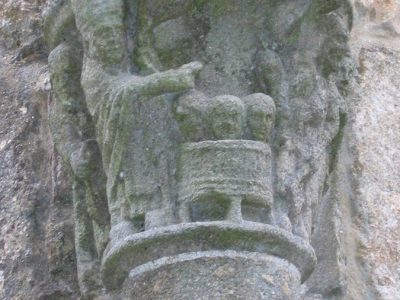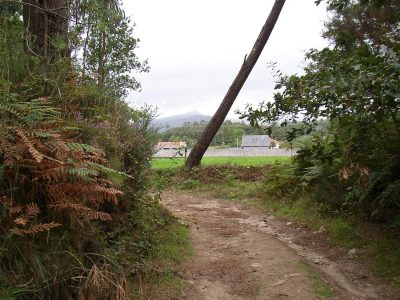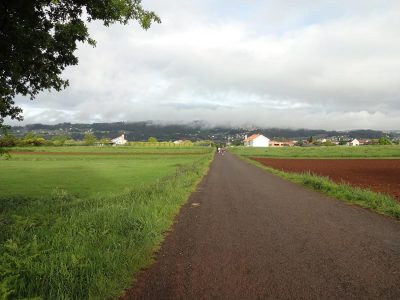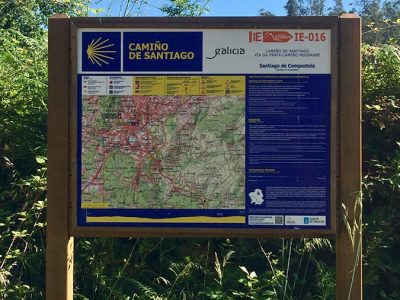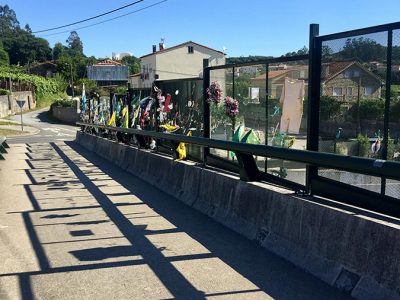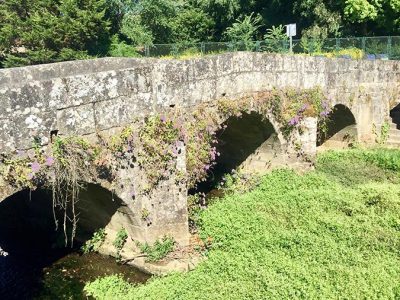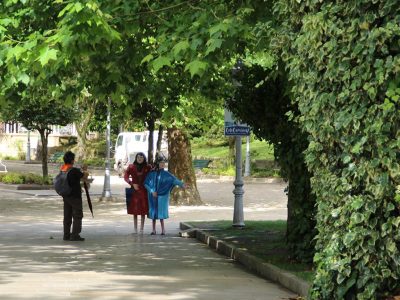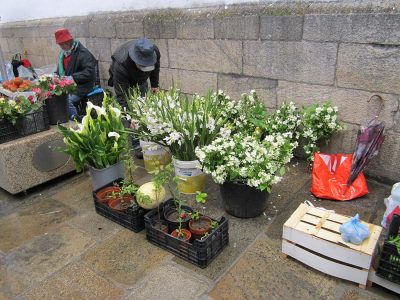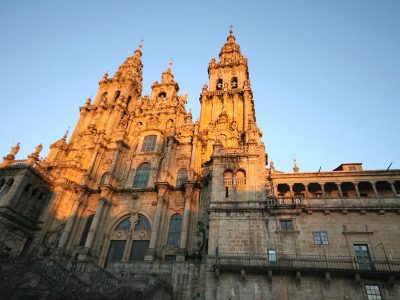42nd Stage
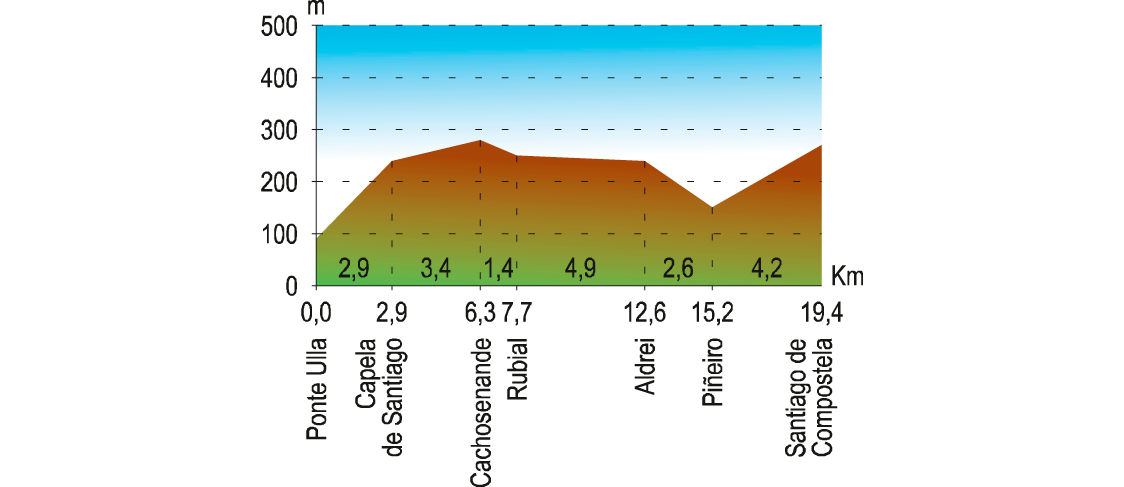
Ponte Ulla – Santiago (19,4 km)
The road from here to Santiago is known as vereda del Ulla. You leave at the Boimorto-Muros road. After about 50 metres, there is a cross on the left, turn to the right almost at a right angle and pass by a large mansion with a magnificent capital representing a miracle of Saint Nicholas, brought from the hermitage of San Xoan de Cova. Go up the cobbled path called “la calzada” (the road). To the left there is a large stone wall that belongs to the Vista Alegre manor house. We leave to another road and then to the national road.
Here you have to be very careful because the crossing is dangerous, the traffic is intense and the vehicles pass at high speed. The dual carriageway has not eliminated traffic on the N-525. After about 500 meters, the road enters on the left to exit again to the road and cross it.
The road zigzags and, after a slight ascent to the right, you leave a small road also to the right. You keep going up but, this time, you go left along a dirt road. At the next fork, continue straight ahead and also at the next, as the path on the right leads directly to Pico Sacro.
Pico Sacro is one of the sacred mounts of Galicia. Its conical vertex contrasts with the undulating forms of the Galician mountains. The ground is of white granite and its summit is magnetic center where all the forces of this hinge rest.
A popular saying goes like this: “Cando o pico sagro cobre o capelo, meniñas de Ulla cobride o mantelo”. From its summit, a vast panorama of about 400 kilometres around is discovered and watched: Santiago, A Ría de Arousa, Valle del Ulla, A Estrada, Silleda, Lalín can be seen among forests and mounts on a clear day. In the field of Legend there is talk of the Castillo de la Reina Lupa and the meadow where the disciples of the Apostle fought with the monster and anointed the bulls.
After walking among pines, eucalyptus trees and oaks for a long time, it ends in an asphalted track with aerial vines on the sides of the path, which takes you to the Chapel of Santiaguiño and the fountain. It is said that these vines were moved from the Campa do Carballo also known as the field of the Romeros. At about 100 meters, you arrive at
Lugar de Outeiro
Parish of Vilanova.
- La Xunta hostel. Tel: 630 941 288. 32 beds.
In this same parish there is a shelter in the place of Picón, only for groups, ask in advance to the City Council (Tel.: 981 814 612)
Along these roads, the pilgrim may have the feeling that they are being called, but they are just the moans of the tall, thin eucalyptus rocked by the wind.
After 6.5 kilometres, it ends in an asphalted road with some traffic, crossing another that goes to the left towards Milleiros and Cachosenante. Further ahead is the Castrelo crossroads and shortly after you reach Rubial. You will pass by the Rural House “Casa de Casal”. At the next crossroads, continue straight on between vine trellises.
After about 8.8 kilometres, there is a sign indicating Os Muiños dos Balegos dos Mogos, the road goes straight on. After having walked 1 kilometre, you pass under the railway track, you arrive at the place of A Picota and take a track in good condition to the Busacos bridge over the Saramo river, a small bridge with a medieval structure with two identical arches in the place of A Gándara and near Deseiro de Abaixo. Walk 1.5 km more and you leave at the N-525, near is the
- Albergue Reina Lupa 679 842 829
and you arrive at A Susana, with bars and services and the cobs hanging from the “fallados”.
The path leaves on the left, towards O Outeiro de Morrazos, then on the right, with a climb, you pass the place of Cañoteira de Marrozos with a fountain and a pass under the road. The trellises on the path continue to accompany you towards Aldrey, where there is a cross and fountain. From here you cross the railway underneath and enter the place of Vixoi, at the fork turn left and then in front, playing right and left you go down towards the river and you reach the hermitage of Santa Lucia: a foot bath resumes the march, then Piñeiro and then “a costiña do Demo” and not even the shade of the vines serve as comfort. You cross the rúa de San Cristovo, go straight ahead, next to it there is a high-voltage tower. You cross a bridge over the road and you end up in the Camino Real de Angrois.
A few metres further on you will see the Angrois or Sar crossroads, cross the road from Santiago to Rodiño and, along a paved and parallel path, go down towards Santa María de Sar. A good fountain refreshes you. From here the towers of the Cathedral have a wonderful perspective. The road leaves you on the road at the height of the Collegiate Church of Santa María la Mayor del Sar with its columns inclined towards the interior of the earth (as if they wanted to join down there) It was founded by Munio Afonso in 1136, but its completion is due to Archbishop Gelmirez. It passes the Ponte de Sar.
SANTIAGO
One enters the city of the Apostle by the Rua do Sar, Castrón Douro slope, Patio de Madres, Porta de Mazarelos, Praza de Mazarelos, Fonte Seca, Rúa do Castro, Rúa de Xelmírez, Praza das Praterías, entering the Cathedral, either by the Platerías door or by the Holy Door in Jubilee Year.
Silence is now synonymous with emotion. For these thousands of steps on legendary lands, forgotten of the passage of pilgrims but beating in each stone, in each fountain, in each piece of the way the memory of those who once passed through them.
If the emotion when arriving at Santiago by the French Way is undescriptible, what can be said about this deep emotion nourished in silence, hardness and solitude?
Herru Santiago!
- Minor Seminary Hostel. Av Quiroga Palacios, 2 Tel: 881 031 768. santiago@alberguescamino.com 173 places. Prices according to season
- Hostel “Suso”. Rúa do villar, 65, Tel: 981 586 611
- Pension Residence “Fonseca”. Rúa de Fonseca, 1-2º. Tel: 603 259 337

